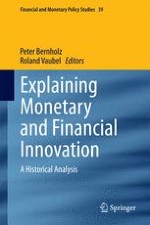2014 | OriginalPaper | Chapter
The Emergence and Innovations of the Eurodollar Money and Bond Market: The Role of Openness and Competition Between States
Authors : Torsten Saadma, Roland Vaubel
Published in: Explaining Monetary and Financial Innovation
Publisher: Springer International Publishing
Activate our intelligent search to find suitable subject content or patents.
Select sections of text to find matching patents with Artificial Intelligence. powered by
Select sections of text to find additional relevant content using AI-assisted search. powered by
